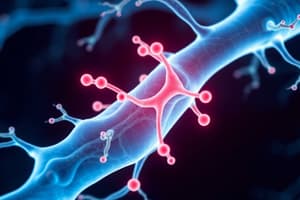Podcast
Questions and Answers
Which receptor is primarily responsible for detecting vibrations?
Which receptor is primarily responsible for detecting vibrations?
- Ruffini's Corpuscle
- Pacinian Corpuscle (correct)
- Merkel's Disc
- Meissner's Corpuscle
What term describes the ability of Pacinian corpuscles to quickly cease responding to continuous stimulus?
What term describes the ability of Pacinian corpuscles to quickly cease responding to continuous stimulus?
- Sustained adaptation
- Phasic response
- Tonic response
- Rapid adaptation (correct)
Which sensory modality is NOT part of the somatic senses?
Which sensory modality is NOT part of the somatic senses?
- Hearing (correct)
- Temperature
- Pain
- Touch
What characteristic distinguishes fine or discriminatory touch from crude touch?
What characteristic distinguishes fine or discriminatory touch from crude touch?
What types of sensations do Ruffini's corpuscles primarily detect?
What types of sensations do Ruffini's corpuscles primarily detect?
Which of the following describes the concept of spatial discrimination?
Which of the following describes the concept of spatial discrimination?
What is the role of lateral inhibition in sensory perception?
What is the role of lateral inhibition in sensory perception?
Which cutaneous receptor is primarily responsible for detecting light touch?
Which cutaneous receptor is primarily responsible for detecting light touch?
What determines the effectiveness of two-point discrimination?
What determines the effectiveness of two-point discrimination?
Which area of the body has the smallest receptive fields?
Which area of the body has the smallest receptive fields?
What is the primary role of lateral inhibition in sensory perception?
What is the primary role of lateral inhibition in sensory perception?
Which type of receptor changes its firing rate in response to temperature changes?
Which type of receptor changes its firing rate in response to temperature changes?
What is the function of the labelled line code in the somatosensory system?
What is the function of the labelled line code in the somatosensory system?
Which of the following best describes spatial discrimination ability?
Which of the following best describes spatial discrimination ability?
How do receptive fields differ in size across various body parts?
How do receptive fields differ in size across various body parts?
Which process occurs at each relay point in the sensory pathway to enhance signal processing?
Which process occurs at each relay point in the sensory pathway to enhance signal processing?
Which mechanoreceptors are primarily responsible for sensing stretch around joints?
Which mechanoreceptors are primarily responsible for sensing stretch around joints?
What characteristic describes the receptive fields of mechanoreceptors in the somatosensory cortex?
What characteristic describes the receptive fields of mechanoreceptors in the somatosensory cortex?
Lateral inhibition primarily enhances which aspect of sensory processing?
Lateral inhibition primarily enhances which aspect of sensory processing?
Thermoreceptors are mainly responsible for detecting what type of sensory information?
Thermoreceptors are mainly responsible for detecting what type of sensory information?
The capacity for spatial discrimination in the somatosensory cortex is enhanced by which of the following?
The capacity for spatial discrimination in the somatosensory cortex is enhanced by which of the following?
Which layer of the somatosensory cortex is primarily involved in processing specific sensory modalities?
Which layer of the somatosensory cortex is primarily involved in processing specific sensory modalities?
Which area of the somatosensory cortex is known for integrating information from different sensory systems?
Which area of the somatosensory cortex is known for integrating information from different sensory systems?
Damage to the somatosensory cortex would likely impair which of the following functions?
Damage to the somatosensory cortex would likely impair which of the following functions?
Flashcards
Thermoreceptors
Thermoreceptors
Receptors that change their firing rate as temperature changes in a specific direction.
Somatosensory System
Somatosensory System
Part of the nervous system that provides information about body parts stimulated.
Labelled-line code
Labelled-line code
A system that identifies the location of a stimulus based on which neurons are activated.
Dermatome
Dermatome
Signup and view all the flashcards
Receptive Field
Receptive Field
Signup and view all the flashcards
Two-point Discrimination
Two-point Discrimination
Signup and view all the flashcards
Lateral Inhibition
Lateral Inhibition
Signup and view all the flashcards
Sensory Pathways
Sensory Pathways
Signup and view all the flashcards
Mach Bands
Mach Bands
Signup and view all the flashcards
Somatosensory System
Somatosensory System
Signup and view all the flashcards
Sensory Receptors (touch)
Sensory Receptors (touch)
Signup and view all the flashcards
Touch (submodalities)
Touch (submodalities)
Signup and view all the flashcards
Pacinian Corpuscle
Pacinian Corpuscle
Signup and view all the flashcards
Pacinian Corpuscle structure
Pacinian Corpuscle structure
Signup and view all the flashcards
Pacinian Corpuscle Function
Pacinian Corpuscle Function
Signup and view all the flashcards
Meissner's Corpuscle
Meissner's Corpuscle
Signup and view all the flashcards
Ruffini's Corpuscle
Ruffini's Corpuscle
Signup and view all the flashcards
Merkel's Disc
Merkel's Disc
Signup and view all the flashcards
Primary Somatosensory Cortex
Primary Somatosensory Cortex
Signup and view all the flashcards
Somatosensory Cortex Organization
Somatosensory Cortex Organization
Signup and view all the flashcards
Somatosensory homunculus
Somatosensory homunculus
Signup and view all the flashcards
Secondary Somatosensory Cortex (SII)
Secondary Somatosensory Cortex (SII)
Signup and view all the flashcards
Somatosensory Association Cortex
Somatosensory Association Cortex
Signup and view all the flashcards
Body Part Representation in Cortex
Body Part Representation in Cortex
Signup and view all the flashcards
Study Notes
Somatosensory System
- Somatic senses perceive touch, temperature, proprioception (position sense), and pain.
- Information comes from skin, joints, muscles, and viscera.
Sensory Receptors
- Touch receptors are specialized epithelial cells or neuronal endings in the skin.
- Two main touch submodalities:
- Fine/discriminatory touch (two-point discrimination)
- Crude touch (itch, tickle - poorly localized)
Cutaneous Sensory Receptors
- Four distinct receptor types transduce touch:
- Pacinian corpuscle
- Meissner's corpuscle
- Ruffini's corpuscle
- Merkel's disc
Pacinian Corpuscle
- Encapsulated receptor deep in subcutaneous layers of hairy and non-hairy skin.
- Consists of a group II myelinated fiber encased in a lamellar structure (approximately 1mm in diameter).
- Rapidly adapting receptor, suited to detecting vibrations.
- Adaptation results from lamellae adjusting shape during deformation, preventing continuous depolarization for signaling.
- Frequency of firing reflects vibratory signal intensity.
- Poorly localizing due to large receptive fields.
Meissner's Corpuscle
- Consists of group II myelinated fibers in a small capsule.
- Found densely in fingertips, lips.
- Rapidly adapting receptor, useful for encoding tapping and flutter.
- Small receptive fields, enabling two-point discrimination.
Merkel's Discs
- Unencapsulated mechanoreceptors in non-hairy skin epidermis.
- Merkel cell enclosed by a nerve ending.
- Small receptive fields, enabling precise location.
- Slowly adapting receptors.
- Ideal for detecting stimulus location.
Ruffini's Corpuscles
- Nerve terminal in a liquid-filled collagen capsule.
- Depolarize in response to skin deformation (any input).
- Slowly adapting receptor.
- Large receptive fields.
- Encoding information regarding stimulus magnitude.
Thermoreceptors
- Located on free nerve endings of myelinated (Aδ) and unmyelinated (C) fibers.
- Separate receptors for cold (optimum sensitivity at 25°C) and warmth (optimum sensitivity at 45°C).
- Very cold (<5°C) or hot (>45°C) stimuli activate pain fibers (thermal nociceptors).
- Receptors transiently change firing rate in response to temperature change direction.
Where is it?
- Somatosensory system provides brain information about body part being stimulated.
- Imagine losing touch sensation to understand possible effects.
Sensory Pathways
- Two primary pathways:
- Dorsal column pathway: transmitting fine touch, pressure, proprioception.
- Anterolateral pathway: conveying pain, temperature, and crude touch.
Dermatomes
- Refers to body areas innervated by neurons in a single spinal nerve.
Clinical Application
- Examples of clinical scenarios involving spinal cord damage and associated sensory losses.
Brown-Sequard Syndrome
- Specifically relates hemisection of spinal cord at T12 and resulting pattern of sensory loss.
Thalamus
- Relay station for all sensory input to the cerebral cortex, except olfaction.
Cortical Processing
- Different cortical areas involved in processing somatosensory information:
- Primary somatosensory cortex (SI): post-central gyrus, Brodmann's areas 1, 2, and 3 - topographic map "homunculus".
- Secondary somatosensory cortex (SII): superior bank of the lateral fissure, another map but more diffuse.
- Somatosensory association cortex: areas 5 and 7, integrating information from different sensory systems.
Primary Somatosensory Cortex
- Contra-lateral representation of somatic senses (except fibers from face).
- Larger areas for lips, thumb, face; smaller areas for other body parts.
- Columns arranged in vertical column, each for a specific sensory modality - tactile, pain, temperature.
- Contains orientation and direction-sensitive properties.
Somatosensory Association Cortex
- Synthesizes primary and secondary input.
- Involved in complex sensory associations.
- Stimulating this area can elicit complex body sensations, like the sensation of a tool.
Damage to Somatosensory Cortex
- Damage can affect drawing, spatial relations and two-point discrimination.
Studying That Suits You
Use AI to generate personalized quizzes and flashcards to suit your learning preferences.




